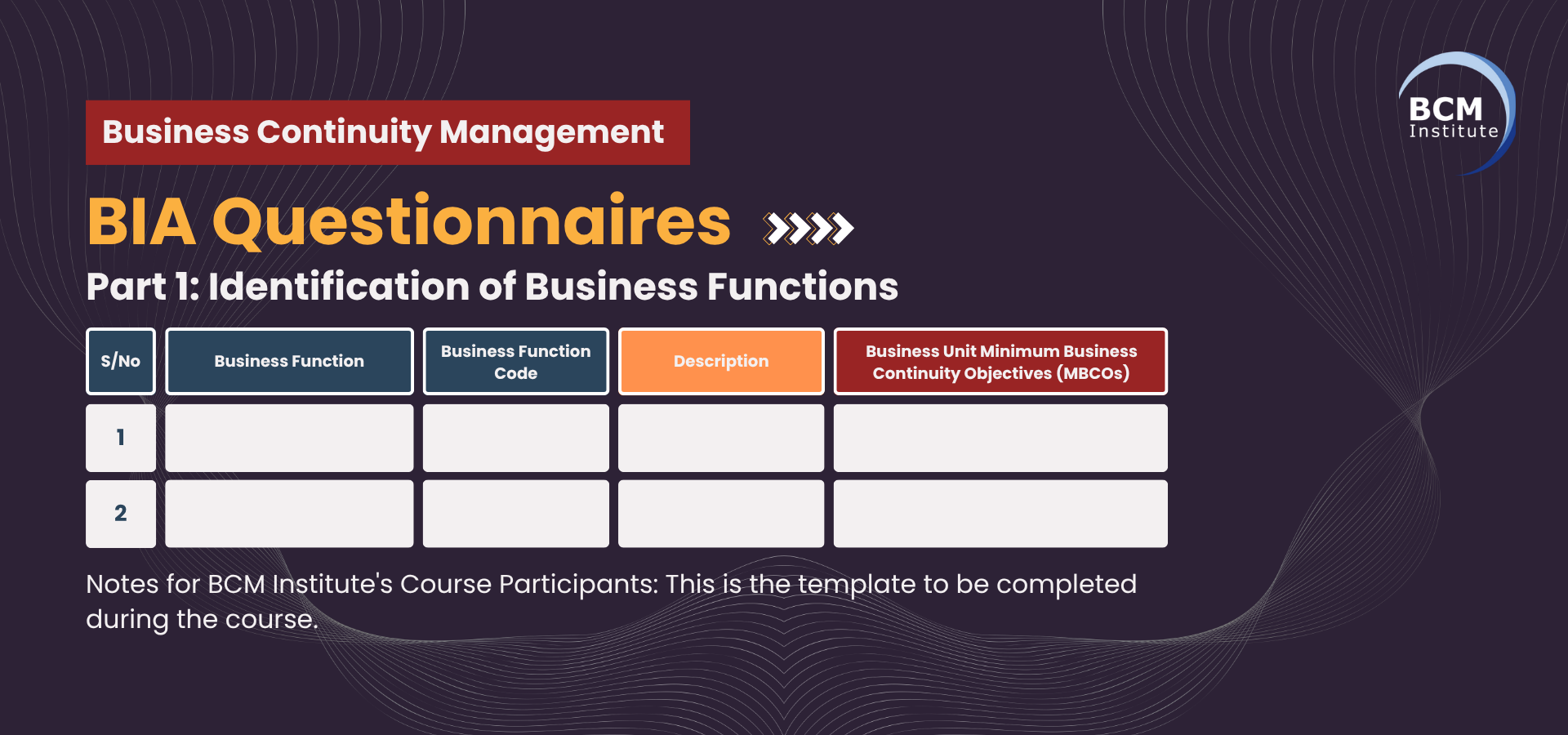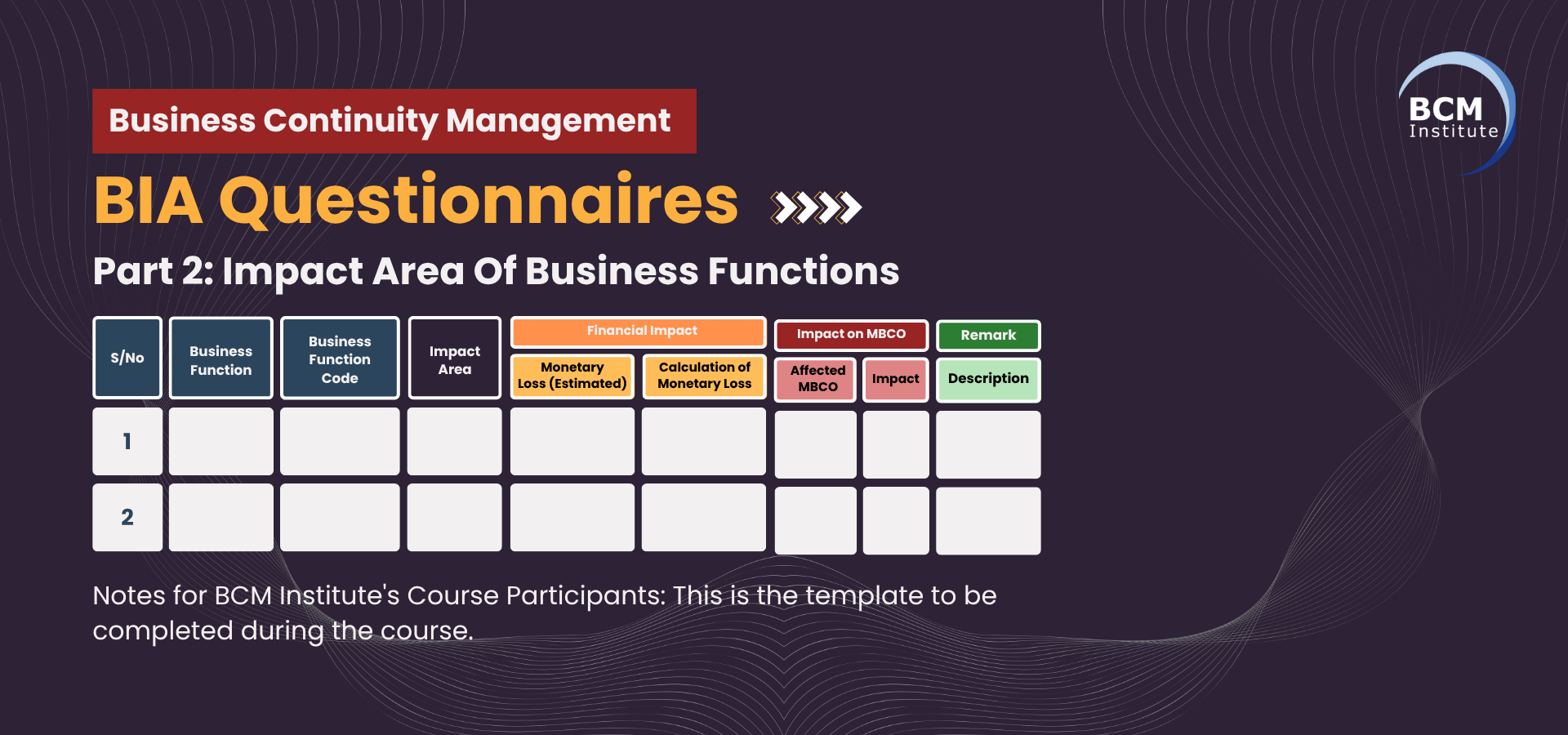[Business Impact Analysis] [Critical Business Function] [T1] Part 1

Part 1: Identification of Business Functions
CBF-1: Labour Market Regulation and Enforcement
![[BCM] [MOM] [E3] [BIA] [T1] [CBF] [1] Labour Market Regulation and Enforcement](https://no-cache.hubspot.com/cta/default/3893111/6eaa5c4f-0bd6-4343-85a8-d94449364aa5.png)
The Ministry of Manpower (MOM) plays a pivotal role in shaping Singapore’s labour market, ensuring that employment standards, workplace safety, and labour relations are effectively regulated and enforced.
Within the framework of Business Continuity Management (BCM), MOM’s critical business functions must be systematically identified, evaluated, and prioritised to guarantee continuity of essential public services in the event of disruptions.
One such critical business function is CBF-1: Labour Market Regulation and Enforcement, which encompasses the development of policies, issuance of licenses, regulatory monitoring, adjudication, and enforcement of labour laws.
The effectiveness of this function ensures that Singapore’s workforce remains protected, employers comply with statutory requirements, and overall labour market integrity is preserved.
Using the BCM concept of the Minimum Business Continuity Objective (MBCO), each sub-function is mapped to its criticality. The MBCO reflects the minimum level of service a business unit must deliver during a disruption to prevent unacceptable consequences to MOM’s mandate, national workforce stability, and public trust.
Table 1: Business Unit Minimum Business Continuity Objective (MBCO) of Sub-CBFs for CBF-1
|
Sub-CBF Code |
Sub-CBF |
Description of Sub-CBF |
Business Unit Minimum Business Continuity Objective (MBCO) |
|
1.1 |
Policy & Regulation Design |
Formulation and review of labour policies, regulations, and standards to ensure alignment with national objectives and international obligations. |
Maintain essential policy drafting and advisory capacity to provide interim guidance on urgent labour market issues within 5–10 working days. |
|
1.2 |
Licensing & Permits |
Processing and issuance of employment-related licenses and permits (e.g., work passes, foreign worker quotas). |
Ensure core licensing systems remain operational at a minimum of 50% capacity within 48 hours to support essential manpower movement and employer compliance. |
|
1.3 |
Inspections, Monitoring & Investigation |
Conducting workplace inspections, monitoring employer compliance, and investigating potential breaches of labour laws. |
Sustain critical field inspection and investigation activities at 30–40% capacity within 72 hours, prioritising high-risk industries and urgent safety cases. |
|
1.4 |
Adjudication & Dispute Resolution |
Resolving disputes between employers and employees through tribunals, mediation, and adjudication processes. |
Maintain dispute resolution services at a minimum level (20–30% case handling) within 3–5 working days to prevent escalation of employment conflicts. |
|
1.5 |
Enforcement Actions & Sanctions |
Initiating enforcement actions, imposing penalties, and applying sanctions against non-compliant entities. |
Retain essential enforcement capability (10–20% of cases) within 72 hours to deter systemic non-compliance and protect workers’ rights. |
|
1.6 |
Stakeholder Engagement & Education |
Providing guidance, outreach, and educational initiatives for employers, workers, and unions on compliance and best practices. |
Ensure delivery of urgent advisories and stakeholder communication at 50% capacity within 24 hours to sustain public trust and industry compliance. |
|
1.7 |
Regulatory Intelligence & Risk Management |
Gathering intelligence, analysing trends, and identifying emerging risks in the labour market for proactive regulatory responses. |
Maintain minimal intelligence-gathering and risk monitoring functions (20–30% capacity) within 5 working days to enable proactive interventions. |
Summing Up … for Part 1
CBF-1 Labour Market Regulation and Enforcement is at the core of MOM’s mandate to maintain a fair, safe, and sustainable labour ecosystem in Singapore.
The continuity of this function ensures not only the stability of employment relationships but also the nation’s economic resilience during crises.
By defining the MBCO for each sub-function, MOM can prioritise resources, establish continuity strategies, and ensure that even under severe disruption, the most critical labour market regulatory services continue to operate at an acceptable minimum.
This structured approach strengthens MOM’s operational resilience, safeguards public trust, and upholds the ministry’s role as the steward of Singapore’s workforce and labour standards.
 [Business Impact Analysis] [Critical Business Function] [T1] Part 2
[Business Impact Analysis] [Critical Business Function] [T1] Part 2

Part 2: Impact Area Of Business Functions
CBF-1: Labour Market Regulation and Enforcement
The Ministry of Manpower (MOM) plays a central role in shaping Singapore’s labour market, ensuring that regulations are upheld and maintaining a fair, progressive, and sustainable employment environment.
As part of its critical business functions (CBF), MOM is tasked with Labour Market Regulation and Enforcement (CBF-1), which encompasses a wide range of processes, from policy design to regulatory enforcement.
Given the impact of these functions on Singapore’s economy, workforce well-being, and social stability, it is essential to identify and evaluate the Sub-CBFs that underpin this high-level CBF.
Each Sub-CBF has potential impact areas, financial implications, and varying degrees of influence on the Minimum Business Continuity Objective (MBCO).
The table below outlines the Sub-CBFs within CBF-1, the associated impact areas, and their contribution to sustaining MOM’s overall operational resilience.
Table 2: Impact Area Of Business Functions of Sub-CBFs for CBF-1
|
Sub-CBF Code |
Sub-CBF |
Impact Area |
Financial Impact – Monetary Loss (Estimated) |
Financial Impact – Calculation of Monetary Loss (State Formula for Calculations) |
Impact on MBCO – Affect MBCO |
Impact on MBCO – Impact |
Remarks – Description |
|
1.1 |
Policy & Regulation Design |
Strategic / Regulatory Compliance |
High (e.g., S$10M – S$50M annually if ineffective policies cause systemic labour disruptions) |
Loss = GDP Impact × % Workforce Disruption × Duration (in months) |
Yes |
Critical – Policy failures disrupt the entire labour market framework |
Development of fair and sustainable labour policies that balance employer and worker needs. |
|
1.2 |
Licensing & Permits |
Legal / Operational / Reputational |
Moderate to High (e.g., S$5M – S$20M if delays hinder businesses and foreign worker entry) |
Loss = (No. of Delayed Permits × Average Business Loss per Worker per Month) |
Yes |
Significant – Direct impact on workforce deployment and employer operations |
Issuance of work passes and permits essential for businesses to employ foreign manpower. |
|
1.3 |
Inspections, Monitoring & Investigation |
Legal / Compliance / Safety |
High (e.g., S$10M – S$30M from workplace accidents, non-compliance fines, reputational damage) |
Loss = (No. of Incidents × Average Compensation/Legal Penalty) + Reputational Cost Factor |
Yes |
Critical – Workplace safety and compliance underpin MOM’s credibility |
Conduct inspections, ensure fair labour practices, and address breaches of employment laws. |
|
1.4 |
Adjudication & Dispute Resolution |
Legal / Industrial Relations |
Moderate (e.g., S$2M – S$10M due to unresolved disputes leading to strikes or productivity losses) |
Loss = (No. of Disputes × Avg. Productivity Loss per Day × Duration) |
Yes |
High – Failure to resolve disputes may escalate into industrial action |
Mediation and resolution of employer–employee disputes, including wage and contract matters. |
|
1.5 |
Enforcement Actions & Sanctions |
Legal / Deterrence / Reputational |
High (e.g., S$5M – S$25M if enforcement lapses result in exploitation or systemic non-compliance) |
Loss = (No. of Non-Compliant Cases × Penalty Avoided) + Enforcement Resource Costs |
Yes |
Critical – Weak enforcement erodes deterrence and public trust |
Sanctioning non-compliant employers and workers to ensure fairness and deterrence. |
|
1.6 |
Stakeholder Engagement & Education |
Reputational / Social / Compliance |
Moderate (e.g., S$1M – S$5M if poor communication leads to widespread non-compliance) |
Loss = (No. of Stakeholders Misguided × Avg. Compliance Cost × Non-Compliance Rate) |
Yes |
Moderate – Impacts the effectiveness of the overall compliance regime |
Public awareness campaigns, industry engagement, and education on labour market regulations. |
|
1.7 |
Regulatory Intelligence & Risk Management |
Strategic / Risk / Policy |
High (e.g., S$10M – S$40M if risks such as illegal employment or labour exploitation go undetected) |
Loss = (Estimated Workforce Affected × Avg. Economic Cost per Worker × Duration) |
Yes |
Critical – Intelligence gaps undermine policy effectiveness and enforcement |
Collect and analyse data to detect emerging risks, forecast trends, and support evidence-based policymaking. |
Summing Up … for Part 2
The Labour Market Regulation and Enforcement (CBF-1) function of the Ministry of Manpower is a cornerstone of Singapore’s socio-economic stability.
Each Sub-CBF—whether in policy design, licensing, enforcement, or stakeholder engagement—contributes to sustaining an equitable and efficient labour ecosystem.
Disruption or failure in any Sub-CBF can result in significant financial loss, reputational damage, and risks to national resilience.
By mapping the Sub-CBFs against their impact areas, financial implications, and influence on the MBCO, MOM can prioritise its continuity planning and strengthen its preparedness to manage crises.
Ultimately, a robust continuity framework for CBF-1 ensures that MOM can continue to protect the rights of workers, uphold fair employment practices, and maintain Singapore’s competitiveness as a global labour hub—even in times of disruption.
More Information About Business Continuity Management Courses
To learn more about the course and schedule, click the buttons below for the BCM-300 Business Continuity Management Implementer [BCM-3] and the BCM-5000 Business Continuity Management Expert Implementer [BCM-5].




![[BCM] [MOM] [E3] [BIA] MBCO Corporate MBCO](https://no-cache.hubspot.com/cta/default/3893111/91c07ac1-2f4d-4acf-a002-df50ac7e8f19.png)
![[BCM] [MOM] [E3] [BIA] [P&S] Key Product and Services](https://no-cache.hubspot.com/cta/default/3893111/904a4659-6e74-4f50-a27d-b0543463d80a.png)
![[BCM] [MOM] [E3] [RAR] [T1] List of Threats](https://no-cache.hubspot.com/cta/default/3893111/41c8981e-45dd-416c-90e0-55c3a22753da.png)
![[BCM] [MOM] [E3] [RAR] [T2] Treatment and Control](https://no-cache.hubspot.com/cta/default/3893111/02909b01-2511-4249-864b-967afcc727bc.png)
![[BCM] [MOM] [E3] [RAR] [T3] Risk Impact and Likelihood Assessmen](https://no-cache.hubspot.com/cta/default/3893111/fd3dd074-a74d-45ec-8219-3cee4c0463c4.png)
![[BCM] [MOM] [E3] [BCS] [T1] Mitigation Strategies and Justification](https://no-cache.hubspot.com/cta/default/3893111/06674b8b-3cf9-4855-a89a-ecd2baa9a395.png)
![[BCM] [MOM] [E1] [C10] Identifying Critical Business Functions](https://no-cache.hubspot.com/cta/default/3893111/f19dbb07-448c-4021-9605-82ad98643d7f.png)
![[BCM] [MOM] [E3] [BIA] [DP] [CBF] [1] Labour Market Regulation and Enforcement](https://no-cache.hubspot.com/cta/default/3893111/ff0a9479-fa3e-41a8-ba7b-9d151a715d05.png)
![[BCM] [MOM] [E3] [BIA] [T2] [CBF] [1] Labour Market Regulation and Enforcement](https://no-cache.hubspot.com/cta/default/3893111/bcb5337e-1bdd-47dc-b0af-399dfc78021a.png)
![[BCM] [MOM] [E3] [BIA] [T3] [CBF] [1] Labour Market Regulation and Enforcement](https://no-cache.hubspot.com/cta/default/3893111/bbc0c267-3d28-497d-9504-5d1853058e7b.png)
![[BCM] [MOM] [E3] [BCS] [T2] [CBF] [1] Recovery Strategies](https://no-cache.hubspot.com/cta/default/3893111/c295a198-de84-41b2-be64-0a5d39bf87fe.png)
![[BCM] [MOM] [E3] [BCS] [T3] [CBF] [1] Minimum Resources Required during a Disaster](https://no-cache.hubspot.com/cta/default/3893111/68673062-6e5b-4e51-9226-4da013aaaa0e.png)
![[BCM] [MOM] [E3] [PD] [CBF] [1] Labour Market Regulation and Enforcement](https://no-cache.hubspot.com/cta/default/3893111/2ef54310-5f33-42cd-874b-187f278267ee.png)


![Register [BL-B-3]*](https://no-cache.hubspot.com/cta/default/3893111/ac6cf073-4cdd-4541-91ed-889f731d5076.png)



![FAQ [BL-B-3]](https://no-cache.hubspot.com/cta/default/3893111/b3824ba1-7aa1-4eb6-bef8-94f57121c5ae.png)
![Email to Sales Team [BCM Institute]](https://no-cache.hubspot.com/cta/default/3893111/3c53daeb-2836-4843-b0e0-645baee2ab9e.png)





